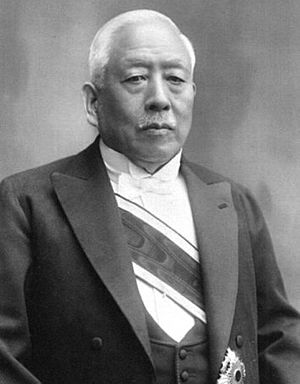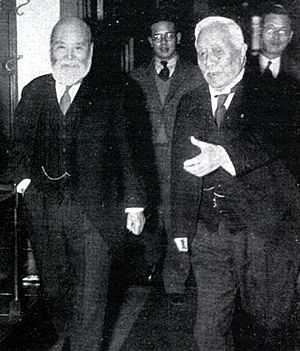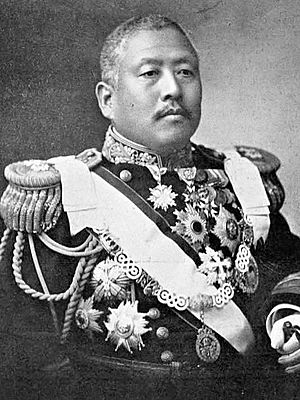Saitō Makoto facts for kids
Quick facts for kids
Saitō Makoto
|
|
|---|---|
| 斎藤 実 | |
 |
|
| Lord Keeper of the Privy Seal of Japan | |
| In office 26 February 1935 – 26 February 1936 |
|
| Monarch | Shōwa |
| Preceded by | Makino Nobuaki |
| Succeeded by | Ichiki Kitokurō |
| Prime Minister of Japan | |
| In office 26 May 1932 – 8 July 1934 |
|
| Monarch | Shōwa |
| Preceded by | Korekiyo Takahashi (Acting) |
| Succeeded by | Keisuke Okada |
| Governor-General of Korea | |
| In office 17 August 1929 – 17 June 1931 |
|
| Monarch | Shōwa |
| Preceded by | Hanzō Yamanashi |
| Succeeded by | Kazushige Ugaki |
| In office 1 December 1927 – 10 December 1927 |
|
| Monarch | Shōwa |
| Preceded by | Kazushige Ugaki (Acting) |
| Succeeded by | Hanzō Yamanashi |
| In office 12 August 1919 – 14 April 1927 |
|
| Monarch | Taishō Shōwa |
| Preceded by | Yoshimichi Hasegawa |
| Succeeded by | Kazushige Ugaki(Acting) |
| Minister of the Navy | |
| In office 7 January 1906 – 16 April 1914 |
|
| Prime Minister | Saionji Kinmochi Katsura Tarō Yamamoto Gonnohyōe |
| Preceded by | Yamamoto Gonnohyōe |
| Succeeded by | Yashiro Rokurō |
| Personal details | |
| Born | 27 October 1858 Mizusawa Domain, Mutsu Province, Japan |
| Died | 26 February 1936 (aged 77) Tokyo, Japan |
| Political party | Independent |
| Spouse | Saitō Haruko (1873–1971) |
| Alma mater | Imperial Japanese Naval Academy |
| Awards | Order of the Chrysanthemum Order of the Bath (Honorary Knight Grand Cross) |
| Signature |  |
| Military service | |
| Allegiance | |
| Branch/service | |
| Years of service | 1879–1928 |
| Rank | |
| Commands | Akitsushima Itsukushima |
| Battles/wars | First Sino-Japanese War Russo-Japanese War World War I |
Viscount Saitō Makoto (born October 27, 1858 – died February 26, 1936) was an important Japanese naval officer and politician. He served in many high-ranking positions. These included being the Prime Minister of Japan and the Governor-General of Korea.
Saitō Makoto became well-known during the First Sino-Japanese War. He quickly rose through the ranks in the navy. By 1900, he was a rear admiral. He became a vice admiral during the Russo-Japanese War in 1904. After serving as the Minister of the Navy, he became Governor-General of Korea twice. In 1932, he became Prime Minister after Inukai Tsuyoshi was assassinated. He was later assassinated himself in 1936.
Saitō Makoto was born in Mizusawa, Japan. His father was a samurai from the Mizusawa Clan. In 1879, he finished his studies at the Imperial Japanese Naval Academy. He was one of the top students in his class. He became an ensign in 1882 and a sub-lieutenant in 1884.
Military Career and Rise to Admiral
In 1884, Saitō traveled to the United States. He spent four years there studying as a military attaché. This means he was a military expert working at an embassy. When he returned to Japan in 1888, he joined the Imperial Japanese Navy General Staff.
He quickly moved up in rank. In 1893, he became a lieutenant commander. He then served on the cruiser Izumi and the battleship Fuji.
During the First Sino-Japanese War, Saitō was a captain. He commanded the cruisers Akitsushima and Itsukushima. His leadership helped him get promoted quickly. By 1900, he was a rear admiral.
Political Career and Leadership Roles
Saitō Makoto continued his important work during the Russo-Japanese War. He was promoted to vice admiral in 1904. After the war, he became the Navy Minister. He held this job for eight years, from 1906 to 1914. During this time, he worked hard to make the Japanese navy stronger.
In 1907, he was given the title of danshaku (baron). This was part of the kazoku peerage system, which recognized important families. In 1912, he became a full admiral. However, he had to leave his Navy Minister job in 1914 because of a scandal.
Governor-General of Korea
In 1919, Saitō was chosen to be the third Japanese Governor-General of Korea. This was a very important role. He took the job right after the March 1st Movement, which was a big movement for Korean independence. He even survived an assassination attempt by a Korean nationalist.
He served as governor-general of Korea two times. First from 1919 to 1927, and then again from 1929 to 1931. During his time, he tried to make Japan's policies towards Koreans more fair. In 1925, his title was raised to shishaku (viscount).
Prime Minister of Japan

In May 1932, the Prime Minister, Inukai Tsuyoshi, was assassinated. This was a very serious event. To prevent the military from taking over the government, Saitō Makoto was chosen to be the new Prime Minister.
During his time as Prime Minister, Japan made some big decisions. Japan recognized the independence of Manchukuo, a state in Northeast Asia. Japan also left the League of Nations, an international organization.
Saitō's government lasted longer than some others during that time. It ended in July 1934 when his cabinet resigned due to a bribery scandal. Keisuke Okada then became the Prime Minister.
Later Life and Assassination
Saitō Makoto remained an important figure in Japanese politics. He became the Lord Keeper of the Privy Seal in December 1935. This was a very close advisor role to the Emperor.
However, his life ended tragically. On February 26, 1936, he was assassinated at his home in Tokyo. This event was part of the February 26 Incident, when some military officers attacked several top politicians. His friend, Takahashi Korekiyo, who was also a former prime minister, was killed on the same day. Saitō and Takahashi were the last former prime ministers of Japan to be assassinated until 2022.
Honors and Awards
Saitō Makoto received many honors for his service to Japan. After his death, he was given the highest honor, the Supreme Order of the Chrysanthemum.
- Peerages:
- Baron (1907)
- Viscount (1925)
- Decorations:
- Order of the Sacred Treasure (various classes, starting 1893)
- Order of the Golden Kite (various classes, starting 1896)
- Grand Cordon of the Order of the Rising Sun (1906)
- Grand Cordon of the Order of the Rising Sun with Paulownia Flowers (1924)
- Grand Cordon of the Order of the Chrysanthemum (1936, after his death)
- Foreign Decorations:
- Honorary Knight Grand Cross of the Order of the Bath (United Kingdom, 1906)
- Knight 1st Class of the Order of the Red Eagle (Kingdom of Prussia, 1907)
- Knight Grand Class of the Order of Saints Maurice and Lazarus (Kingdom of Italy, 1907)
- Grand Officer of the Legion d'Honneur (France, 1907)
- Knight Grand Cross of the Order of Orange-Nassau (Netherlands, 1911)
- Knight Grand Cross of the Order of St. Sylvester (Holy See, 1922)
- Knight Grand Cross of the Order of Pius IX (Holy See, 1932)
See also
 In Spanish: Saitō Makoto para niños
In Spanish: Saitō Makoto para niños


